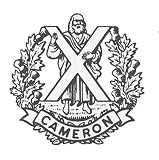79th Highlanders
| Queen's Own Cameron Highlanders | |
|---|---|

Cap Badge of the Queen's Own Cameron Highlanders
|
|
| Active | 1793–1961 |
| Country | Kingdom of Great Britain (1793–1800) |
| Branch |
|
| Type | Infantry |
| Role | Line infantry |
| Part of | Highland Brigade |
| Garrison/HQ | Cameron Barracks, Inverness |
| Motto(s) | Pro rege et patria (For King and country) |
| March | Quick (Band): The Cameron Highlanders Quick (Pipes): Pibroch O' Donuil Dhu Slow (Band): Logie O' Buchan |
| Commanders | |
| Colonel-in-Chief | HRH The Duke of Edinburgh |
| Insignia | |
| Tartan |
Cameron of Erracht Royal Stuart (Pipes) |
The Queen's Own Cameron Highlanders or 79th (The Queen's Own Cameron Highlanders) Regiment of Foot was a line infantry regiment of the British Army, raised in 1793. It amalgamated with the Seaforth Highlanders (Ross-shire Buffs, The Duke of Albany's) to form the Queen's Own Highlanders in 1961.
The regiment was raised as the 79th Regiment of Foot (Cameronian Volunteers) on 17 August 1793 at Fort William from among the members of the Clan Cameron by Sir Alan Cameron of Erracht.
The regiment was deployed briefly to Ireland and southern England, then to Flanders in 1794 where it took part in an unsuccessful campaign under the command of the Duke of York during the French Revolutionary Wars. On its return to England the 79th Foot was listed for disbandment, with the men being drafted into other units. In the end the regiment was reprieved, being instead posted to the West Indies in 1795; after a two-year tour the 79th returned to England again. The regiment was again in action against the French at the Battle of Alkmaar in October 1799 during the Helder Campaign. In 1800 the 79th was part of a force that took part in a failed assault on the Spanish coast at Ferrol.
The 79th Foot landed in Egypt as part of an expeditionary force to prevent French control of the land route to India and saw action at the Battle of Abukir in March 1801. After victories at Battle of Mandora and Battle of Alexandria later that month, the British forces forced the surrender of the French forces at Cairo. Along with other regiments that took part in the Egyptian campaign the 79th Foot were henceforth permitted to bear a sphinx superscribed EGYPT on its colours and badges. The 79th spent the next two years in Menorca and a second battalion was formed in 1804.
...
Wikipedia
